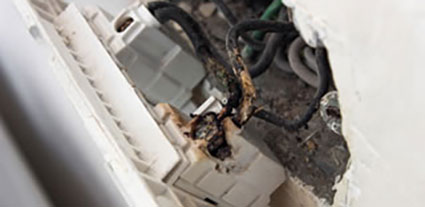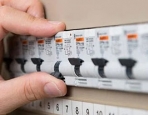Usually, when an electrical fault occurs in the home, the corresponding circuit breaker will trip and immediately cut off the flow of electricity. Sometimes, the main switch may trip, leaving your whole house without electricity.
Quickly identifying the source of an electrical fault following a power outage is essential for the safety of yourself, your family, and your home. If the problem isn’t quickly identified and rectified, serious consequences could result. Did you know that approximately 11 Australian workers per year die because of an electrical fault? It’s no matter to scoff at!
To locate the source of electrical faults, you’ll need some basic knowledge about electrical circuits and how they work. An electrical circuit comprises various electrical components, such as pumps, fans and motors, switches, relays, lights, fuses, fusible links, and circuit breakers. By learning how to read a wiring diagram, you’ll be able to locate electrical faults with speed and ease.
1. Ensure your safety
The first and most vital step towards finding electrical faults in the home is to ensure your safety. Ensure all of the electrical products around your home have been installed to meet your area’s building regulations. If you’re in doubt, consult with an electrician to find out if it’s safe to proceed.
Before starting any electrical work, make sure to follow these precautions:
• Switch off your mains power at the fuse box. Isolate any circuit you’re planning to work on by removing its circuit fuse. Keep it in your pocket or a secure space to avoid losing it.
• Alternatively, switch the breaker off and lock it if possible.
• Attach a note to the fuse box to advise others of your plans to work on the circuit.
• Check if the circuit is dead with a socket tester, or for lighting circuits, use a voltage meter.
2. Check appliances
The first diagnostic step to take is to check if one of your plug-in appliances isn’t working. These kinds of appliances are one of the most common causes of electrical faults.
If a plug-in light isn’t working, you can try changing its bulb. For other types of appliances, try plugging them into a different socket first. If the device starts working, you’ll know the original socket is likely to be faulty and needs replacement. If it doesn’t start working, try the appliance on another power circuit–preferably on another floor. If it works, you’re probably dealing with a dead circuit.
If the appliance still isn’t working after all your testing, it may have a faulty internally. You may need to return it to the store you purchased it from or contact a professional for repairs.
3. Dealing with dead circuits
If you identify a dead circuit, unplug all appliances and turn off all lights connected to the circuit. At your fuse box, turn off the main switch and either reset the circuit breaker/RCD or repair the circuit fuse. Then, you can turn the main switch on again.
Next, switch on each appliance and light within the circuit to determine which device is making the circuit breaker trip. When you identify the device, isolate its circuit again, then check the flex, connections, and fuse.
If the circuit breaker trips or the fuse blows again, there may be a fault in the fixed wiring. This is a problem only a professional can manage, so contact a qualified and experienced domestic electrician.
4. Dealing with faulty ceiling or wall lights
The next thing to check is your wall and ceiling lights. If you identify that one isn’t working, you should first check all other lights on the same circuit. If they are all nonfunctional, follow the steps for dealing with dead circuits.
If the other lights within the circuit are working fine, turn off the faulty light at the switch and install a new bulb.
If the new bulb doesn’t solve the problem, turn off the power and check all cable and flex connections at the light. If required, strip back the light’s cores and remake any connections, making sure screws are tight. With the power still off, check the flex’s condition with a continuity tester. If necessary, replace it.
If you still haven’t solved the problem, try turning the power off again, removing the switch cover and checking any cable connections. If the connections are loose, you’ll need to remake them. If they seem fine, replace the switch.
When you’ve exhausted all of the above steps, and you’re still having wall or ceiling light troubles, it’s time to contact a qualified electrician.
5. When all circuits are dead
If you determine that all circuits on your property are dead, here are the steps to follow.
If a residual current device or RCD protects your home, check if it has tripped. If it has, reset it. If the RCD trips again, carry out all the above checks for appliances, lights, and dead circuits. If the problem remains after trying all of these steps, it’s time to let a professional electrician take over.
Alternatively, check online, call your electricity supplier, or consult with your neighbours to find out if your neighbourhood’s electricity has been cut. If it hasn’t–and if you can’t find any issues with your domestic circuits–you’ll need to contact your electricity supplier. They’ll check your service fuse and main supply cable and work to fix the problem.



